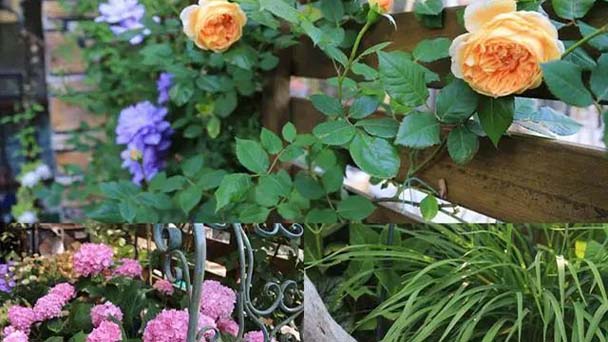Designs for how to grow a small garden
Written by Joy
Sep 29 2020

How is designing a small garden different from designing a large garden? Small space gardening is usually ignored in garden design manuals. Garden design usually appears in the form of a series of principles or rules. The key elements of growing a small garden are also valuable, but they are often displayed on a large scale. Most of us don't have a lot of land to carefully calculate the width and length of our perennial border. Many of us do not have the time or inclination to bear the maintenance costs of these gardens.

Whatever your reason for growing a small garden, there is no reason why you can't be a well-designed display stopper. In fact, any plant or garden style can be used in a small garden space. The principles of good garden design still apply, but you need to adjust them slightly.
Challenge for Small garden growing design
The entire garden can be considered as a whole. Some small garden spaces will be able to adapt to hidden turning paths and can even be divided into garden rooms, but in most cases, small gardens can be photographed in one go. This means that more than ever, your garden will be treated as a work. There is no doubt that you will make adjustments in the next few years, but starting to some extent can save you the time and energy of constantly moving.Limited space means you will have to make choices. You cannot grow every kind of plant you love. For most gardeners, this may be the most daunting challenge. You will need to curb your urges and buy plants when impulsive, assuming you will find a place. Shopping according to your garden plan will help you focus on the most suitable plants in your garden.
The color should also be limited, giving your small garden cohesion, less is more. You can start with a palette of 2-3 colors. You can always add some accent color plants. Cooler colors will make the garden appear larger and give the garden a sense of depth. You can use various textures to compensate for the limited palette. The texture contrast will help to blend various plants and make the garden flow.
Every plant or function needs to achieve its purpose. There is no space to waste space or poorly performing plants. Plants should provide at least two seasons of interest, preferably three to four seasons when growing a small garden.
Skills for growing little garden
First, designing becomes easier when you can take the entire photo at once.Second, it needs fewer plants to produce a dramatic effect. Just you should make sure you are not planting one of them. Too many different individual plants can cause confusion. It's a good choice to find some well-growing plants and plant them in large blocks, repeating the clumps throughout the garden.
Third, gardeners learn about every space and plant in the small garden. Any inappropriate or unprosperous plants can be quickly discovered and corrected. ruthless. If you can't compost a rusty plant yourself, at least moving it out of sight will restore it.
Fourth, the small garden is suitable for being enclosed. You may not want to install stone walls, but flowering or evergreen hedges will give the illusion of a secret garden. A simple low boxwood edge transforms a small garden into a formal garden. Fences and fences enclose and define spaces for entertainment or children's play.
A small space garden is suitable for personal expression. The smaller garden is an extension of your family and tells about the sensitivity and taste of the gardener. If these tastes and sensitivities should be changed, it is much easier to grow a small garden.
Latest Updated
- Benefits of Bugleweed - 7 Science-backed Health Benefits
- Bugleweed Dangers & Side Effects - Is It Poisonous?
- How to Plant Evergreen Trees - What You Should Know
- When to Plant Evergreens - Grow Guide for Evergreen Trees
- 12 Wonderful Evergreen Shrubs for Your Garden
- 12 Popular Evergreen Plants with Pictures for Beginners
- When And How To Prune A Lilac Bush Like a Pro
- How to Grow & Care for Lilac Vine (Hardenbergia Violacea)
- Japanese Lilac Tree (Syringa Reticulata) Care & Propagation Guide
- Shumard Oak Pros and Cons - What to Know
Popular Articles
- Winter maintenance of Antirrhinum Majus
- How to Grow Terminalia Mantaly Tree
- How to Grow and Care for Crossostephium Chinense
- How to grow Antirrhinum Majus in spring
- Peristeria Elata (Dove Orchid) Profile: Info & Care Guide
- Underwatered Snake Plant (Sansevieria Trifasciata) - Signs And How To Fix
- How to Care for Brazilian Jasmine Plant (Mandevilla Sanderi)
- How to Grow & Care for Graptopetalum Purple Delight in Summer
- Rosa Chinensis (China Rose): Plant Growing & Care Tips
- How to Care for Baby Sun Rose (Aptenia Cordifolia)